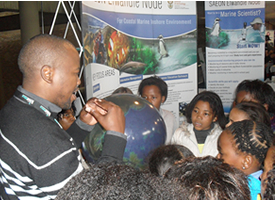| 42% of getS.E.T.go! readers think that the development of a 3D touch screen is a great idea and an exciting development for science. | |
| 17% are indifferent. | |
| 40% think it’s a waste of money and a gimmick. |
It is estimated that South Africa’s new Science & Technology Train, which is currently under development, will reach 14 000 learners each year.
Transnet Rail Engineering at Koedoespoort will complete the train’s renovations.
Seven days of science extravaganza
 |
SAIAB’s Science Advancement Co-ordinator, Vanessa Rouhani; Managing Director Professor Paul Skelton; Scifest Africa Director Anja Fourie; and Karen Anderson from SAIAB, holding prizes for the SAIAB competition draw. The winner was Litha Somdyala from Masixole Secondary School in Mdantsane. Somdyala will receive a hamper from SAIAB consisting of posters, booklets and two reference books that have been signed by the authors – “A Complete Guide to the Freshwater Fishes of Southern Africa” by Paul Skelton and “Coastal Fishes of Southern Africa” by Phil and Elaine Heemstra. |
|
 |
Learners at Scifest Africa. |
By Siphokazi Nonyukela of SAIAB
Learners, students, teachers and science enthusiasts from around the country flocked to this year’s Scifest Africa, the annual national science extravaganza that was held in Grahamstown from 4 to 10 May.
Themed “Science across Cultures,” this year’s festival looked at what makes us human, what makes us different, the universality of science, the contribution of different cultures (past and present), as well as the development of modern science and particularly the contribution that indigenous knowledge systems make to mankind.
The chemistry of conservation
With 2011 being the International Year of Chemistry, the South African Institute for Aquatic Biodiversity’s (SAIAB) took the opportunity to highlight the National Fish Collection, showcasing the chemistry behind the curation procedures involved in conserving different aquatic specimens for future generations. The display included banners with in-depth information about the organisation and the collections facility, as well as specimens and simple models of the atoms that bond to form the chemicals used to preserve fishes and other aquatic organisms. A competition for learners with inquisitive minds was held to promote their engagement with and awareness of SAIAB.
SAIAB also ran apprenticeships throughout Scifest, in which Grade 11 and 12 learners and members of the public could spend a morning gaining hands-on experience of what SAIAB scientists do in their day-to-day research. This included sessions on how to preserve fish and the different chemicals used in preservation, saving endangered species through Geographic Information Systems (GIS) and a day in the life of a research assistant.
Dr Gavin Gouws, Aquatic Biologist at SAIAB, hosted a talk on the barcoding process, illustrating the DNA barcode and how it is generated and implemented in the laboratory. SAIAB’s Chief Scientist, Professor Alan Whitfield, took his group on a guided tour of the estuaries between the Great Fish and Kowie Rivers, highlighting the different types of estuaries and some of the animals and plants living in these specialised systems.
PUB stand draws a crowd
Melissa Gopaul, who helped to man the Public Understanding of Biotechnology (PUB) Progamme exhibit, has only good things to say about Scifest Africa 2011. “It eventually all became a blur, with educators quizzing you on material, Department of Education officials wanting to know more about the workshops we present, small children being interested in the Periodic Table of Elements we displayed, and high school learners wanting to know about the salaries biotechnologists earn,” she says.
PUB is proud to have reached about 6 000 learners and more 200 educators at this year’s event!
